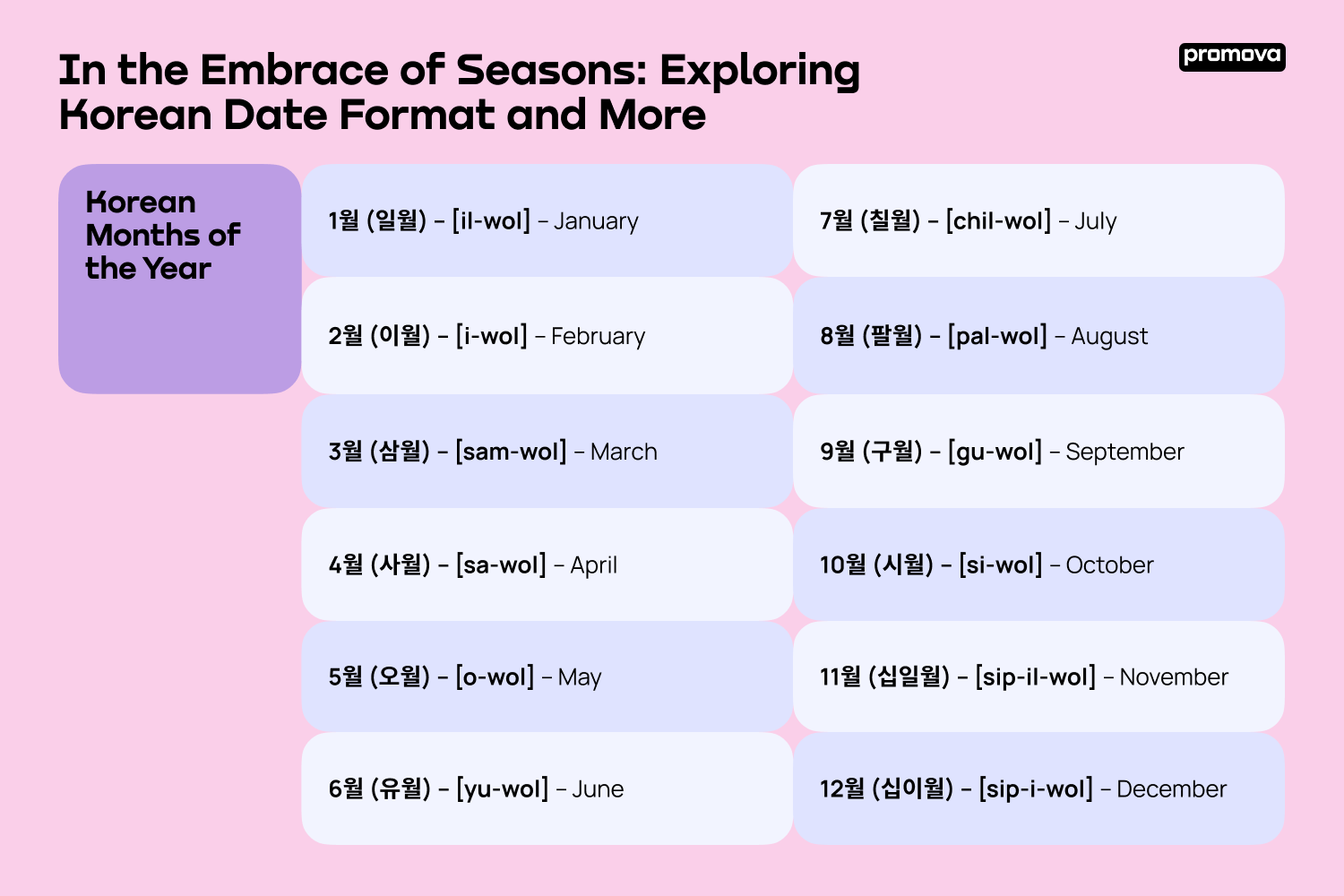In the Embrace of Seasons: Exploring Korean Date Format and More

Contents
Whether you are studying Korean for an upcoming trip or because you have a genuine interest in the language, understanding the Korean date format and knowing the names of the months is crucial. It will help you communicate with locals and discuss various topics. And today, we’ll help you with that! Buckle up!
Introduction to Dangun: Understanding the Korean Calendar
Today, most people in Korea use the Gregorian calendar for civil and practical purposes. However, it wasn’t always like that. Not everyone knows that, but until the end of the XIX century, locals lived according to the unique Korean calendar, called Dangun. It is based on a lunar system, meaning that the months are determined by the moon's phases.
Now, this Korean calendar is still used in traditional and cultural contexts with the Gregorian one. Koreans use it to determine holidays and cultural events, like the Lunar New Year.
Date Format Basics: Writing Dates in Korean
Another thing worthy of knowing about Koreans is their written date format, especially if you intend to work for a Korean-speaking company. In most situations, written communication is more than essential. So, what’s with the dates? To write them appropriately, you need to follow the specific order of elements – yyyy.mm.dd. For example:
2021년 5월 10일 – May 10, 2021.
1998년 12월 25일 – December 25, 1998.
This format is quite different from those we use in English. Depending on the location, we either use mm.dd.yyyy (American English) or dd.mm.yyyy (British English).
Korean Months of the Year
Now you are all set, and we can finally move to the main topic – the names of the months in Korean. In the list below, you will find all the information you need, alongside examples of using these names in casual sentences.
- 1월 (일월) – [il-wol] – January in Korean.
예쁜 눈이 내린 1월의 아침은 정말 아름답습니다. (There’s nothing quite like a beautiful, snowy January morning.)
1월은 저에게 새로운 시작의 달이기 때문에 1월을 좋아합니다. (I love January because, for me, it’s the month of new beginnings.)
저는 매년 1월이면 1년 동안의 새로운 목표를 세웁니다. (Every January, I set new goals for the year ahead.)
- 2월 (이월) – [i-wol] – February in Korean.
2월에는 보통 설날을 맞이하여 가족끼리 모여 음식을 함께 먹습니다. (In February, families usually get together to share food in celebration of the Lunar New Year.)
내년 2월에 열대 기후로 여행을 가고 싶어요. (I want to travel to a tropical climate next February.)
추운 날씨를 피해 2월에 여행을 계획하고 있습니다. (We’re planning a trip in February to escape the cold weather.)
- 3월 (삼월) – [sam-wol] – March in Korean.
3월에는 봄이 시작되어 꽃들이 피어나기 시작합니다. (March marks the beginning of spring, and the flowers begin to bloom.)
제 남자친구는 3월에 태어났고 전형적인 물고기자리입니다. (My boyfriend was born in March, and he is a typical Pisces.)
3월에 봄방학을 맞아 멕시코로 떠납니다. (In March, I’m heading to Mexico for spring break.)
- 4월 (사월) – [sa-wol] – April in Korean.
4월에는 벚꽃이 만발하여 사진 찍기에 최적의 시기입니다. (In April, the cherry blossoms are in full bloom, making it a great time to take photos.)
4월의 날씨는 덥지도 춥지도 않아서 좋아요. (I love the weather in April because it’s not too hot and not too cold.)
4월에 결혼식이 있어서 그 달에는 꽤 바쁠 것 같아요. (I have a wedding in April, so I’ll be pretty busy that month.)
- 5월 (오월) – [o-wol] – May in Korean.
5월에는 따뜻한 날씨와 함께 식물이 우거지는 모습을 볼 수 있습니다. (In May, you can see plants thriving along with warm weather.)
저는 솔직히 5월이 일 년 중 가장 좋은 달이라고 생각합니다. (I honestly think May is the best month of the year.)
5월에 대학을 졸업할 예정인데, 제 인생의 다음 장을 빨리 시작하고 싶어요. (I’m graduating from college in May, and I can’t wait to start the next chapter of my life.)
1
- 6월 (유월) – [yu-wol] – June in Korean.
6월에는 여름이 시작되어 날씨가 점점 더워집니다. (In June, summer begins, and the weather gets hotter.)
생일에 참석할 수 없습니다. 6월 내내 파리에 있을 거예요. (I can’t attend your birthday. I’ll be in Paris for the whole of June.)
6월에 결혼을 앞두고 있는데 이보다 더 기쁠 수 없습니다! (I’m getting married in June, and I couldn’t be happier!)
- 7월 (칠월) – [chil-wol] – July in Korean.
7월에는 해변으로 나들이를 떠나는 사람들로 붐볐습니다. (July was a busy month for beachgoers.)
7월에 계획이 있으신가요? 근처 도시에서 멋진 축제가 열릴 예정이에요. (Do you have plans in July? There’s a great festival coming up in a city near you.)
7월에 호수에서 바비큐 파티가 열릴 예정이니 여러분을 초대합니다! (We’re having a barbecue on the lake in July, and you’re invited!)
- 8월 (팔월) – [pal-wol] – August in Korean.
8월에는 더운 여름을 보내고 가을이 다가오는 것을 느낄 수 있습니다. (In August, you can feel the approach of autumn after spending the hot summer.)
저는 8월에 태어났고, 제 사자자리 성격은 항상 드러납니다. (I was born in August, and my Leo personality always comes through.)
8월에 꼭 필요한 휴가를 위해 해변으로 떠날 예정입니다. (I’m heading to the beach in August for a much-needed vacation.)
- 9월 (구월) – [gu-wol] – September in Korean.
9월에는 수확의 계절인 가을이 시작됩니다. (September marks the beginning of autumn, the season of harvest.)
저는 9월의 짧은 기간 동안 매우 더워지는 것을 좋아합니다. 겨울이 오기 전 따뜻한 날씨를 즐길 수 있는 마지막 기회와도 같거든요. (I love how hot it gets for a short period of time in September. It’s like our last chance to enjoy the warm weather before winter arrives.)
9월부터 새로운 업무를 시작하기 때문에 변화에 대한 기대가 큽니다. (I’m starting a new job in September, so I’m excited about the changes.)
- 10월 (시월) – [si-wol] – October in Korean.
10월에는 단풍 구경을 하러 산으로 나가는 사람들이 많습니다. (In October, many people go to the mountains to see the autumn leaves.)
10월은 으스스한 계절이라서 동생이 좋아하는 달입니다. (October is my brother’s favorite month because it’s spooky.)
제 생일이 10월인데 올해는 코스튬 파티를 열어볼까 생각 중입니다. (My birthday is in October, and I’m thinking of throwing a costume party this year.)
- 11월 (십일월) – [sip-il-wol] – November in Korean.
11월에는 시원한 바람이 부는 가을의 매력을 느낄 수 있습니다. (In November, you can feel the charm of autumn with cool breezes.)
11월에 이미 크리스마스 분위기를 느낄 수 있다는 점이 마음에 듭니다. (I love that you can already feel the Christmas spirit in November.)
11월에 새로운 취미를 시작하려고 뜨개질을 배우려고 해요! (I’m starting a new hobby in November, and I’m going to learn to knit!)
- 12월 (십이월) – [sip-i-wol] – December in Korean.
12월에는 크리스마스 분위기가 가득하여 거리마다 환하게 빛납니다. (In December, the streets are lit up with Christmas cheer.)
매년 12월이 기다려지는 이유는 온 가족이 한자리에 모이는 달이기 때문입니다. (I look forward to December every year because it’s the month that brings the whole family together.)
12월에 연말연시를 맞아 가족을 방문할 예정입니다. (I’ll be visiting my family in December for the holidays.)

Memorize the Name of Every Month in Korean with Promova
Mastering a new language is an exciting process that consists of tons of minor steps, and learning the names of the months is just one of them. However, if you want to become fluent, you need to take a complex approach, focusing on all four basic skills – reading, speaking, writing, and listening. You can definitely do that by yourself, especially if you have the essential resources. The Promova application is the perfect opportunity for you to master foreign languages.
Our convenient app was designed by language experts to provide you with the best materials. Here, you can learn Korean, Spanish, French, German, English, Arabic, and many other tongues, including even the ASL. The best part of it is that you can study several tongues at the same time, making it easier for you to realize which ones you are really interested in.
The main purpose of the app is to allow you to study anywhere and anytime. We are focusing on bite-sized learning, meaning that you can only spend a few minutes every day and still get the essential results. Moreover, this approach allows you to keep your attention on important things without feeling overwhelmed by tons of unnecessary information.
The Promova app is available for iOS and Android devices, so you can easily install it and start your language learning path without any delays. Whether lying in bed or standing in traffic, the Promova application will always be handy in terms of mastering foreign tongues. So what are you waiting for? Get the app now, and make your learning exciting and convenient!
Conclusion
Summing up, we can say that learning the names of the months in Korean is essential for every learner. This topic is widely used on various occasions, whether these are job settings or casual conversations. Therefore, if one of your goals is to become fluent in Korean, it is vital to pay attention to this simple subject. We hope that today’s article will help you nail it. And, as always, we’re looking forward to seeing you in the next one!
FAQ
How do you say day, month, and year in Korean?
The word “day” in Korean is 날 (nal). To say “year,” use the word 년 (nyeon). And if you need to say “month,” use the word 월 (wol). The last one is actually already familiar to you, as you can see it at the end of the name of every month.
How can I calculate my Korean age, and does it differ from the actual age?
Yes, according to the calendar in Korean, your age will definitely differ from the actual one because, in this country, every person becomes one year older on New Year’s Day. So, for example, if you were born on December 1, 2000, in 2024, you must be 24 years old. However, your Korean age is 26 years old. That’s because you are already considered to be 1 year old on the day of your birth, and you’ve become 2 years old on New Year’s Day.
Why do they use numbers for months of the year in Korean?
Just for convenience! The literal translation of the months’ names is actually “first month,” “second month,” “third month,” etc. So, to simplify the writing, locals use actual numbers instead of their written forms. However, both options are correct – you can use 1월 and 일월 interchangeably.
What are the most important Korean holidays?
There are plenty of them! Almost every month, Koreans have something to celebrate, either a global holiday or a traditional one. For example, they celebrate both the traditional New Year on January 1st and the Seollal (설날), the Lunar New Year. Some other holidays include Chuseok (추석) – Korean Thanksgiving, National Foundation Day (개천절), and the Buddha’s Birthday (부처님 오신 날).



Comments